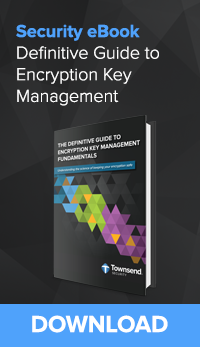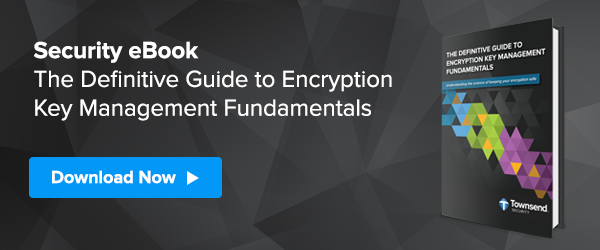Both encryption and proper key management are a crucial part of defending your sensitive data. Consider the massive Marriott/Starwood Resorts data breach that was announced at the end of November, 2018. Attackers were able to first gain access to their systems in 2014, almost a full four years before they were detected in September of 2018.
 To date, it is estimated that over 500 million records were compromised. 327 million of which contain personally identifiable information (PII) like names, physical addresses, birthdays, etc. In a statement put out by their parent company, Marriott, they noted that, “for some, the information also includes payment card numbers and payment card expiration dates, but the payment card numbers were encrypted using Advanced Encryption Standard encryption (AES-128). There are two components needed to decrypt the payment card numbers, and at this point, Marriott has not been able to rule out the possibility that both were taken.” (italics and bolding mine)
To date, it is estimated that over 500 million records were compromised. 327 million of which contain personally identifiable information (PII) like names, physical addresses, birthdays, etc. In a statement put out by their parent company, Marriott, they noted that, “for some, the information also includes payment card numbers and payment card expiration dates, but the payment card numbers were encrypted using Advanced Encryption Standard encryption (AES-128). There are two components needed to decrypt the payment card numbers, and at this point, Marriott has not been able to rule out the possibility that both were taken.” (italics and bolding mine)
So, while the information was encrypted, the company cannot rule out that “two components needed to decrypt” were not taken. One of these needed components would be the encryption keys. No one knows for sure why they they cannot rule this out, but if the encryption keys were properly managed, the potential for them being stolen along with the data would be highly unlikely. Encryption is crucial to securing sensitive information. Just as important: properly managing the encryption keys.
But encryption, and by extension key management, have a bad reputation for being difficult to deploy in the enterprise. Encryption projects used to be costly as well as time and personnel intensive. While many databases came with encryption as part of their native libraries, it was a largely manual process not for the faint-of-heart—and add on top of that finding ways to properly manage the encryption keys; most developers would put it off for another day.
The good news, much has changed in the last 10+ years. Deploying encryption and key management can take a fraction of the time it normally took. But that doesn’t mean to you don’t have to work smart. Coming at an encryption project in a haphazard way could cost you time, money, and sensitive data not getting the proper protection it needs.
Follow along for three tips you need to get your encryption project off on the right direction.
Create a Unified Policy for Encrypting Data-at-Rest
The first step in any project is to get agreement between stakeholders as to what data-at-rest should be encrypted. Some of the obvious contenders would be any cardholder data (CHD) you have in you environment, personal health information (PHI) or personally identifiable information (PII) that needs to be kept safe. Many time this information falls under a compliance regulation like PCI DSS or HIPAA. The choice to encrypt this data is clear.
But less clear is data, that if exposed, would leave your company exposed to brand damage, lawsuits, or loss of competitive advantage. Whether it's the plans for a new product, proprietary schematics for an existing product, or information that exposes your business processes, business has a lot of information they want kept secret.
In fact, Deloitte estimates that Intellectual Property data can constitute more than 80 percent of a enterprise company’s value. Below is a short (and certainly not exhaustive) list of items that your company should be encrypting:
- Product/Solution Documents: If your product or service relies on proprietary information to give you a competitive advantage in the marketplace, you need to encrypt anything that would give your competition a window into how your products or solutions work.
- Research and Development (R&D) Data: In the same vein, any R&D you are conducting is your advantage in tomorrow's competitive landscape. Don't let it be stolen from you because you did not properly secure it.
- Financial Reports: If you don’t want your competitors spying on your financial information, encrypt it.
- Legal Documentation: There is a lot of documentation, that if made public, could tarnish a company's reputation. Harassment settlements, sexual misconduct accusations, financial misdealings, even benign partner agreements—all these need to be kept private and out of the public's eye.
Just as crucial as protecting PII and IP data is protecting any client data you are responsible for. Making sure that client data is safe is of utmost importance. Just one breach could cause major reputational damage and see a loss of current and future contract revenue.
Use Existing Encryption
Most databases now (like SQL Server and MongoDB), as part of their Enterprise editions, come with Transparent Data Encryption (TDE). This encryption encrypts the entire database while at-rest and normally uses either AES or 3DES encryption. This typically takes less time to deploy than column level encryption as there is less configuration to do.
If upgrading to an Enterprise edition is not in the budget, some third party encryption products may be an option. NetLib, for example, file level encryption for SQL Server. It supports all versions of SQL Server from 2000 to 2017 and can save you the upgrade costs from going from Standard or Dev editions to Enterprise.
Learn More: SQL Server Encryption Survey 2018
Use an Established Third Party Vendor for Encryption Key Management
The most important part of a data encryption strategy is the protection of the
encryption keys. Because encryption key management is crucial to data protection, the National Institute of Standards and Technology (NIST) provides guidelines on best practices for key management. NIST Special Publication SP-800-57 provides recommendations for encryption key management.
What this means to you is that managing your encryption keys is not a simple process. Why? Because you must create a defense-in-depth system for your encryption keys. Remember, hackers don’t break your encryption, they steal your keys. And the only way you keep your keys safe is to layer them in protection so that only authenticated and authorized personnel have access to them.
The good news is, there are vendors at the ready who already comply with the highest standards and have both virtual and hardware options. The real trick also is finding one that is both dedicated and affordable. Of course, there are some key manager options provided by public clouds, but they are not a dedicated key manager (i.e. you own the key manager) but rather your keys are housed are a multi-tenant environment as well as the public cloud provider having administrative access. This can get tricky as a public key manager may be compelled by the government to hand over your keys, without your knowledge, and unlock your data. Worse yet, if your data is stored in the same public cloud, the cloud provider would have access both to your keys and data. Unsafe! To learn more, check out our recent blog post on PCI SSC guidance around this issue.
Here at Townsend Security we do things differently. Not only is our Alliance Key Manager a dedicated key manager, you can purchase our key management platform of your choice and use it the way you want. It is that simple. From that point on:
- We never charge you fees for connecting a new end-point.
- We never limit the number of end-points based on the model of the KMS.
- We never limit the number of encryption keys generated or stored.
- We never force you to pay extra fees for software patches.
- We never force you to pay extra fees for routine software upgrades.
We do things a little differently here at Townsend Security and we think that makes encryption just a little easier.

